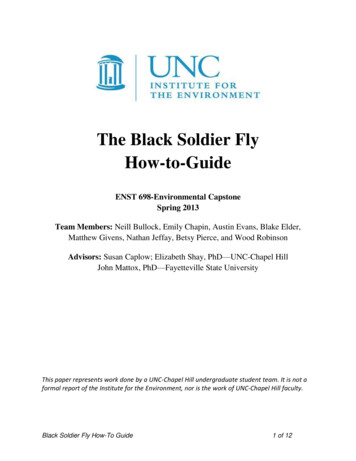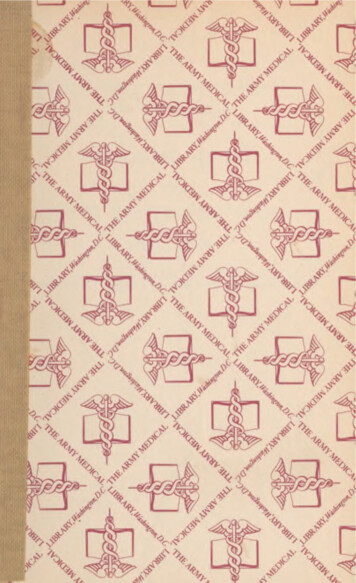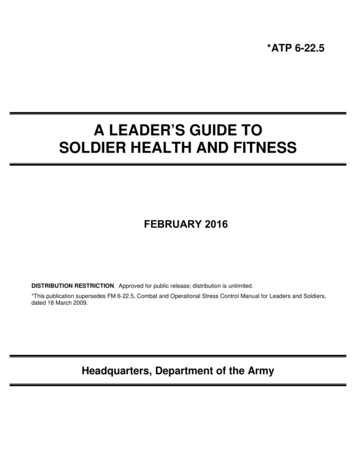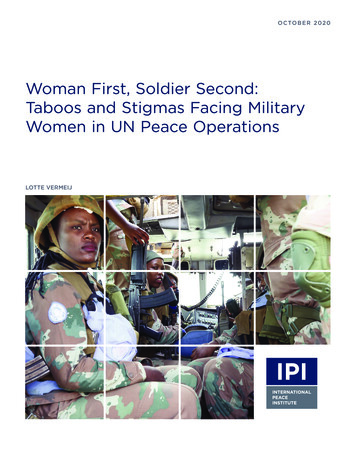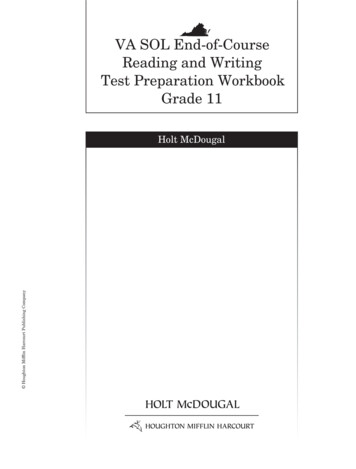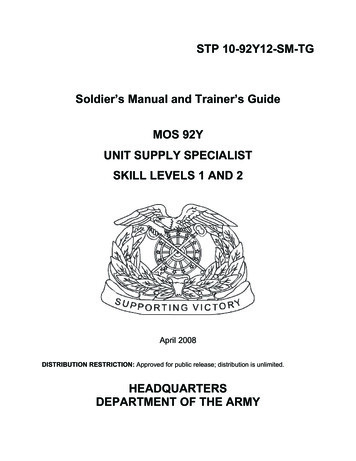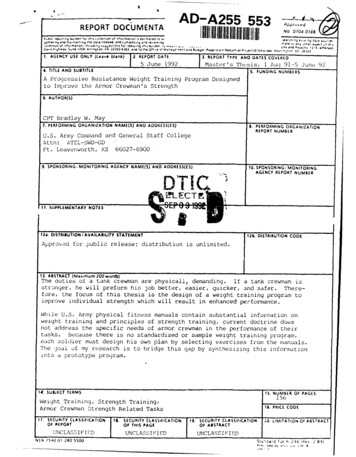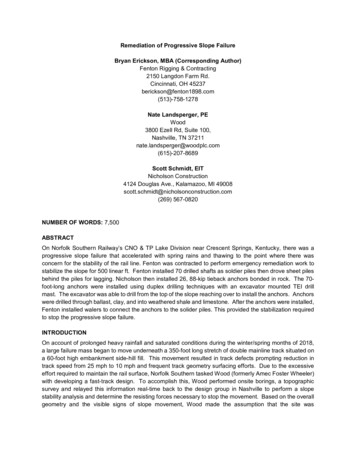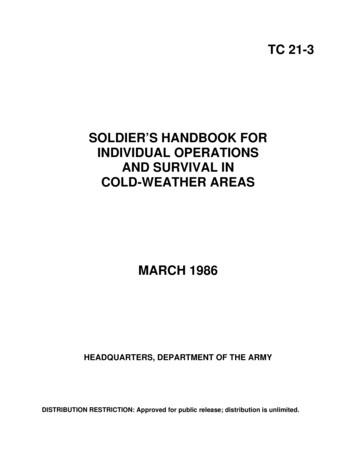
Transcription
TC 21-3SOLDIER’S HANDBOOK FORINDIVIDUAL OPERATIONSAND SURVIVAL INCOLD-WEATHER AREASMARCH 1986HEADQUARTERS, DEPARTMENT OF THE ARMYDISTRIBUTION RESTRICTION: Approved for public release; distribution is unlimited.
*TC 21-3TRAINING CIRCULARNo. 21-3HEADQUARTERSDEPARTMENT OF THE ARMYWashington, DC, 17 March 1986SOLDIER'S HANDBOOK FOR INDIVIDUAL OPERATIONS ANDSURVIVAL IN COLD-WEATHER AREASTABLE OF CONTENTSPREFACE.CHAPTER 1. INTRODUCTION TO COLD-WEATHER OPERATIONS1-1.1-2.1-3.1-4.Cold ConditionsEffects of Cold Weather on Military OperationsOvercoming the ColdPositive Leadership and the Right Attitude1-11-11-21-3CHAPTER 2. PERSONAL CLOTHING AND idual ClothingCold-Wet Versus Cold-DryThe Cold-Weather UniformExtended Cold-Weather Clothing System (ECWCS) (TEST)Tips on Wear and Maintenance of ClothingCold-Weather EquipmentLoad-Carrying EquipmentOver-the-Snow Movement EquipmentMiscellaneous Equipment2-12-22-32-52-62-62-82-92-11CHAPTER 3. TENTS AND HEATING EQUIPMENT3-1. General3-2. Tent Group Equipment3-3. AHKIO3-4. Packing3-5. Ten-Man Arctic Tent3-6. Building Arctic Tents3-7. Instructions for Pitching Tents3-8. Yukon Stove3-9. Precautions3-10. Squad Stove M19503-13-13-23-23-23-33-43-53-63-7* This publication supersedes TC 21-3, 30 September 1974.i
TC 21-3CHAPTER 4. SMALL ARMS AND AMMUNITION4-1. General4-2. Care, Cleaning, and Maintenance4-14-1CHAPTER 5. RATIONS AND DIET5-1. General5-2. Rations5-3. Liquids5-15-15-1CHAPTER 6. HYGIENE AND FIRST AID6-1. General6-2. Hygiene Tips for the Soldier6-3. Hypothermia6-4. Frostbite6-5. Dehydration6-6. Carbon Monoxide Poisoning6-7. Prevention6-8. Sunburn6-9. Tent Eye6-10. Trench Foot/Immersion Foot6-11. Constipation6-12. Diarrhea6-13. Heat Cramps6-14. Heat -10CHAPTER 7. BIVOUAC ROUTINE7-1. General7-2. Bivouac Site7-3. Site Selection7-4. Reconnaissance of Bivouac Site7-5. Trail Plan7-6. Occupation7-7. Bough-Cutting Areas7-8. Garbage7-9. Latrine7-10. Water Points and Snow Areas7-11. Storage7-17-17-17-37-37-47-47-47-47-57-5CHAPTER 8. INDIVIDUAL MOVEMENT8-1. General8-2. Skis8-3. Snowshoes8-18-18-1ii
TC 21-3CHAPTER 9. LAND istance and DirectionMeasuring DistancesDetermining DirectionNavigation by Dead ReckoningHints for the Navigator9-19-19-19-29-29-49-5CHAPTER 10. SURVIVAL10-1. General10-2. Action When Lost10-3. Improvised Shelters10-4. Food10-5. Useful Knots10-110-110-210-810-12APPENDIX A. WIND CHILLA-1APPENDIX B. APPROXIMATE MEASUREMENT CONVERSION FACTORSB-1APPENDIX C. VISUAL EMERGENCY iii
TC 21-3PREFACEThis handbook is an aid for soldiers in cold climates. However, expertise in dealing withcold-weather operations cannot be gained just from reading this handbook. To developsuccessful cold-weather field techniques, application training and operational experienceare necessary. Additional information is available in FM 31-70, FM 31-71, FM 90-11(TBP), and FM 9-207.Military history of operations in northern areas shows that man's success or failure ismeasured by his regard for the dominant characteristics of a cold-weather environment.For a soldier to become a cold-weather expert, he must learn the techniques and rulesneeded to fight and live in a cold-weather climate.The proponent of this publication is HQ TRADOC. Submit changes for improving thispublication on DA Form 2028 (Recommended Changes to Publications and BlankForms) and forward it to Commandant, US Army Infantry School, ATTN: ATSH-B, FortBenning, Georgia 31905-5593.Unless otherwise stated, whenever the masculine gender is used, both men and womenare included.iv
CHAPTER 1Introduction to Cold-Weather Operations"Soldiers in pairs look after each other; be faithfulto your mate; be loyal to your leaders."Anonymous1-1. COLD CONDITIONSCOLD-WETCold-wet conditions occur when temperatures are near freezing and high and lowtemperatures cause alternate freezing and thawing. These conditions can be accompaniedby wet snow and rain, causing the ground to become slushy and muddy. Soldiers needclothing that has a waterproof or water-repellent, wind-resistant outer layer, and an innerlayer with insulation that provide protection in moderately cold weather (above 14oF).Waterproof footwear is essential.COLD-DRYCold-dry conditions occur when average temperatures are lower than 14oF. The ground isusually frozen and the snow dry. Low temperatures plus wind increase the need forprotection of the entire body. For these conditions, soldiers need clothing that willprovide insulation for a wind-chill factor of -80oF. For temperatures below 14oF, whitevapor barrier (VB) boots effective down to temperatures of -50oF must be worn.WIND CHILLWind chill is a measure of the combined effects of wind and temperature. Temperaturealone does not give a true indication of the impact of the cold. In order to effectivelygauge the difference between temperature and the impact of the cold, a wind-chill scalemust be used. The chart in Appendix A is a simple and practical guide showing theconditions under which cold weather is dangerous and when exposed flesh is likely tofreeze. Soldiers must be familiar with the wind-chill chart to recognize these dangers.1-2. EFFECTS OF COLD WEATHER ON MILITARY OPERATIONSCold has a numbing effect on skin, which hinders task performance. This must beconsidered when accomplishing such routine tasks as vehicle maintenance, and makingand striking bivouac areas (FM 9-207).When conditions become extreme and the temperature drops, the problem of survivalbecomes critical. Under these circumstances soldiers may tend to withdraw emotionally,not wanting to leave the warmth and protection of their shelter or tent. The remedy is1-1
TC 21-3physical activity. Try to remain alert and active. Execution of all military duties and thefast and proper performance of group tasks are vital.COCOON-LIKE EXISTENCEMany soldiers, when wearing several layers of clothing and with their heads covered,tend to withdraw within themselves and assume a cocoon-like existence. When soclothed, many soldiers' hearing and field of vision are restricted; they tend not to noticetheir surroundings. Their thinking and reasoning become sluggish.INDIVIDUAL AND GROUP HIBERNATIONThis process is characterized by individuals seeking the comfort of sleeping bags, and bythe group remaining in tents or other shelter. Guard and security measures may beneglected, jeopardizing the security and safety of the unit.1-3. OVERCOMING THE COLDThe body must be protected. It must be kept clean, dry, and warm, with normal bodyprocesses maintained. Rest and nourishment are vital. The right approach to cold-weatherliving will keep you healthy and get you through challenging times. There are four basicrules to follow:KEEP IN SHAPECold-weather clothing and equipment are heavy, and add weight to your normalequipment load. This hinders movement in snow and uses too much energy. Theimportance of being in excellent physical condition cannot be overemphasized. Your unitmust have a tough, challenging, demanding physical training program.DRINK PLENTY OF WATERWater may be hard to get, so you may drink less than you need or only when you arethirsty. This will not give you the water needed to avoid dehydration. Drink plenty ofwater (at least 3.5 quarts per day) to avoid dehydration and fatigue. DO NOT eat snow asa water substitute; it will lower your body's core temperature.EAT TO KEEP FITRegular, nutritious hot food is needed for top performance. You must eat, even when youare not hungry.KEEP A GOOD ATTITUDEYou will meet many new challenges, but none that cannot be overcome. Your attitudetoward the cold will reflect those of your leaders.1-2
TC 21-31-4. POSITIVE LEADERSHIP AND THE RIGHT ATTITUDEMost soldiers, after 3 to 4 weeks of cold-weather training, will be able to cope with theenvironment. Some soldiers may not be as skilled as others, but most will succeed.Set an example for other soldiers. Winter conditions can be frightening, trying to meetchallenges you have never met before. Any mistake could make you a casualty.Aggressive leadership actions that overcome the challenges of the environment areessential to mission accomplishment.There are two enemies to overcome in northern operations: the enemy soldier and thecold. The first step in defeating either enemy is having the right attitude. The cold candefeat you psychologically if you are not aware of the symptoms of a poorly preparedunit. The following are suggestions on how to defeat the cold: If you become depressed or moody, or do not want to talk, force yourself to getinvolved with others. Do not leave out the weaker soldier.If you find it hard to remember things you have been taught, review orders anddrills.Remind soldiers that their jobs are to close with, engage, and gut the enemy, andthat weapons and equipment must be kept in fighting order. Operations in anorthern environment can easily become a camping trip with seriousconsequences. You must avoid this common ambush.Cold weather may slow down the following of an order, but it is not an excuse fornot doing it.Cold weather may make tasks harder and take longer to do, but it will not makethem impossible. With knowledge, proper equipment, and proper training you canovercome the cold and be successful in combat.1-3
CHAPTER 2Personal Clothing and Equipment"The freezing German troops were reduced toremoving clothes from enemy corpses, improvisingstrawboots, and taking other emergency measures."Russia, 19422-1. INDIVIDUAL CLOTHINGSoldiers should understand the design principles of the military cold-weather clothingsystem. These principles are: insulate, layer, and ventilate. There are four ways to makethese principles work for you: keep it Clean, avoid Overheating, wear it Loose, and keepit Dry. By remembering the "buzz word" COLD, you can quickly check your clothing.INSULATEInsulation material reduces the amount of heat loss. By regulating the amount ofinsulation, an individual can regulate the amount of heat lost or retained.Figure 2-1. Insulation.LAYERSeveral layers of clothing provide more insulation and movement than one heavygarment, even if the heavy garment is as thick as the combined layers. Air pocketstrapped between the layers provide insulation and warmth.VENTILATEVentilation helps maintain a comfortable body temperature by allowing excess heat andmoisture to escape.2-1
TC 21-3Figure 2-2. C-0-L-D.KEEP CLOTHING CLEANDirty clothes are cold clothes. Dirt and grease clog the air spaces in clothing and reduceinsulation.AVOID OVERHEATINGSelect comfortable clothing and do not overdress. In cold weather, it is better to be a littlecool rather than risk being overheated.WEAR IT LOOSEAll items of the cold-weather uniform are large enough to allow wearing of theappropriate number of layers. Your field jacket may appear too large without all of thelayers designed to fit under it. If the uniform items do not fit loosely, the insulation thatkeeps you warm will be greatly reduced.KEEP IT DRYIt is important to keep clothing dry, since wet clothing conducts heat away from the bodymore quickly than dry clothing. Moisture soaks into clothing from two directions: theinside and the outside.From the outside you must guard against melting snow; from the inside you must guardagainst sweating. Brush snow and frost from clothing before entering any heated shelteror vehicle, and avoid overheating.2-2. COLD-WET VERSUS COLD-DRYAs mentioned in Chapter 1, temperatures that are above 14 F (-10o C) are consideredcold-wet conditions; temperatures consistently below 14oF will cause cold-dryconditions. Cold-wet conditions usually involve a freeze/thaw cycle, often accompaniedby rain or wet snow. This type of weather is hard to dress for, since each soldier mustbattle the elements to keep his clothing dry. During cold conditions, the ground is usuallyfrozen and the snow is dry. Athough the temperatures during the cold-dry conditions maybe lower than during cold-wet conditions, it is easier to stay warm.2-2
TC 21-3COLD-WETCOLD-DRYORDOWN TO 14oFBELOW 14oFFigure 2-3. Cold-wet versus cold-dry.2-3. THE COLD-WEATHER UNIFORMThere are many layers of clothing that must be worn in a cold weather environment. Thefirst layer of clothing is the T-shirt and shorts. The second layer is a set of thermalunderwear, which consists of an undershirt and underpants. You should wear only theclothing needed to keep comfortable and warm.The scissors-type suspenders must be the last thing next to the outer layer, or else thelayers cannot be tucked inside the trousers. The underpants and all succeeding layers oftrousers are supported from the metal hooks on the suspenders. The suspenders allow theunderpants and trousers to be worn loosely at the waist so that circulation and ventilationare not restricted.Wear the wool shirt outside the trousers, which provides another method of ventilation.You can increase the waist size of this shirt by removing the stitching in each dart at thesides of the shirt.Wear the field trousers as an outer garment in the cold-wet environment. In the cold-dryenvironment, wear the nylon liners inside the field trousers during periods of inactivity.On the inside of each cargo pocket on the trousers is a tape that runs through a hole onthe side of the pocket. The tape ties around the thighs and keeps the cargo in the pocketfrom rubbing and irritating the legs. For warmth and to prevent entry of snow, tie thedrawstrings around your ankles outside the boots into the boot lacing, and tuck thebowknots under the trousers.The field jacket is worn with the liner in both cold-wet and cold-dry areas. Wear the coatand liner directly over the wool shirt. Remove the liner in mild weather or when activityincreases.In a cold-dry environment the parka is worn with a liner. The waist is adjustable forventilation and warmth with a drawcord, and the skirt has a "split-tail" that can be tiedtightly around each leg for warmth. During a period of severe cold, when activity is less,wear the parka with liner over your field jacket with liner. Remember: do not overdressor you will sweat.Do not dry nylon on drying lines too close to the heat; too much heat will melt the nylon,destroying its insulating value.2-3
TC 21-3Keep the head covered to stay warm; a warm head even warms the feet. Wear the coldweather cap or balaclava under your helmet or under the hood to your field jacket. Whenwearing the cold-weather cap as an outer headpiece, the lower flap may be folded up overthe top and fastened with hook-pile tape straps in front. In a cold-dry environment, wearthe winter hood over the cap or the helmet. Adjust the hood by using the drawstrings oneither side of the hood and the elastic strip at the back. To provide minimum protectionfor the face from the wind, bend the wire in the fur cuff of the hood so that you have asmall opening for your face. This allows visibility but less protection.The feet are hard to keep warm and dry, so protect them. The insulated boots (black forcold-wet conditions and white for cold-dry conditions) are warm and waterproof. Thewhite insulated boot is the best cold-weather footwear today. When you are active, yourfeet will sweat and, because of the waterproof rubber lining, the moisture will remain inthe socks or in the bottom of the boots. The feet, even if damp, will stay warm becausethe heat given off by your body will remain inside the boots. If the boots are worn forlong periods, the feet become white and wrinkled when you remove the boots. This is nocause for alarm. Drying, massaging with foot powder, warming and putting on dry sockswill correct this. If you are inactive for long periods, your feet may become cold.Exercises such as knee bends, stamping your feet, running in place, or wiggling your toeswill make them warm. Elevate the feet whenever possible to aid blood circulation. Don'twear socks that are too tight, and wear only one pair of cushion-sole socks at a time.Change your socks at least twice a day. Most important, stay active.Care of your boots is important. Wash boots inside and out with soapy water at least onceper month or as required by unit SOP you want your feet to keep warm, you must keepthe insulation dry. Inspect your shoes often and repair any holes or puncturesimmediately. Temporary repairs can be made by patching the hole with any kind of tape;even chewing gum can be used. Seal the hole quickly to prevent the insulation frombecoming wet. If one of your boots feels heavier than the other, the insulation is probablywet and they should be turned in for new ones.Insulated boots must be tested annually to ensure they are waterproof and have less than0.01 percent moisture in the insulation. The air valve on the outside of the boot is used toequalize pressure when worn at high altitudes and adjusted again upon return to lowaltitudes. To equalize the pressure in the boot, open the valve for a few seconds andimmediately close it. The valve should be kept closed at all other times to preventmoisture from entering. Never open the valve unless the boot pressure around your footcauses discomfort.You can wear overshoes over the leather boots on wet or muddy terrain. The overshoesare not as warm and dry as the insulated boots. Make sure your socks are dry and thatyour boots are loosely laced so as not to restrict circulation.2-4
TC 21-32-4. EXTENDED COLD-WEATHER CLOTHING SYSTEM (ECWCS) (TEST)The ECWCS is issued as a one-for-one replacement for the current standard cold-wetclothing system. System components use the most recent materials and technology. Theresult is a reduction in weight and bulk from the current cold-wet clothing system withoutloss of protection from the cold. The ECWCS uses the layer approach that drawsmoisture away from the body and should be worn as discussed below.FIRST LAYERThis consists of polypropylene undershirt and shorts. They are worn next to the skin.They are designed to draw moisture away from the skin, thereby reducing conductiveheat loss. You must make sure that no other item is placed between these items and yourskin.SECOND LAYERThe second layer contains a synthetic fiber pile (SFP) shirt and polyester batting trouserliners. The SFP shirt and trouser liners provide insulation. The shirt is designed to dryquickly if it becomes wet and to provide a high degree of insulation. It should not beworn as an exterior garment in wet or windy conditions, since the loose weave provideslittle protection against wind chill. If the shirt gets wet, it will reduce the insulation value.The trouser liners are designed to be worn during little or no activity. They should not beworn during heavy activity such as skiing or snowshoeing.THIRD LAYERThis consists of polyester batting field jacket liner and field trousers. The jacket linershould only be used for extra insulation during periods of little activity. This liner isdesigned to be used as a separate jacket; it should not be attached to the parka. Thetrousers provide a durable wind-resistant, water-repellent layer to protect the insulatingunderpants and trouser liners.FOURTH LAYERWindproof, waterproof parka and trousers make up this layer. The parka and trousersprovide windproof and waterproof shell garments to protect the first three layers.The parka should be the outer garment, which is always worn when doing any activityoutside a shelter. It is waterproof, yet the fabric is breathable so that body moisture canescape. The hood is designed to give full protection from wind and snow and does notprevent your seeing the area around you. It has underarm zippers to allow air to circulateduring heavy activity. The trousers are made of the same material as the parka and arevery warm. They should be worn only when necessary to prevent the field trousers frombecoming wet.2-5
TC 21-3FIFTH LAYERThis consists of standard camouflage overwhites.2-5. TIPS ON WEAR AND MAINTENANCE OF CLOTHINGThe previous discussion on the layers of cold-wet and cold-dry uniforms describes howeach system functions. In some units, the cold-dry field trouser liners are oftensubstituted for the wool field trousers of the cold-wet system and function well in a coldwet environment. Your commander and unit standing operating procedure (SOP) willdetermine what uniform and components will be worn and carried in the field.DRYING WET CLOTHINGHang items separately from drying lines inside the tent. Do not place anything too closeto a stove or over steaming pots; steam will cause further dampness.DRYING DAMP CLOTHINGDamp items can be hung on the rucksack during movement. Pin damp socks to loadcarrying equipment or shirt during movement or just inside the last layer of clothing. Donot place damp clothing in sleeping bags. This will only make sleeping bags wet, andthey are harder to dry than clothing.Small items can be placed between the sleeping bag and the sleeping mat under your legs.When washing clothes without soap, dry-rub and air clothing and sleeping bags.Never warm your feet next to an open fire. The boots will melt and burn because of theirinsulation before the feet become warm.Try never to wear VB boots in a sleeping bag. Sometimes the tactical situation is suchthat boots must be worn while sleeping. If so, the feet must be dried and massaged withfoot powder, and dry socks must be put on. Wearing the VB boot while sleeping does notlet your feet dry out. After VB boots have dried, place them underneath your sleeping bagon top of your sleep pad when temperatures are below 0oF.2-6. COLD-WEATHER EQUIPMENTThe sleeping equipment consists of a sleeping bag, an insulated sleeping pad, and awaterproof bag. There are two types of sleeping bags:(1) Sleeping bag type I, intermediate cold, temperature range 45oF to 10oF,consists of a mummy-shaped bag with hood, insulated sleeping pad, and awaterproof bag.2-6
TC 21-3(2) Sleeping bag type II, extreme cold, temperature range of 10oF to -50oF, isalso available.Whatever clothing is necessary must be worn with both bags to stay warm andcomfortable at the lower temperature ranges. As a minimum, long underwear, sleep shirt,dry socks, and head protection should be worn while sleeping.The insulated sleeping pad has replaced the pneumatic mattress. Use the insulatedsleeping pad under the sleeping bag for warmth and comfort and to keep your sleepingbag dry.Figure 2-4. Sleeping pad.The bag must be kept dry if it is to keep you warm. Sleeping bags become wet fromoutside moisture, from sweating on the inside of the bag, and from water escaping fromthe mouth or nose into the sleeping bag.To keep outside moisture from wetting the bag, place protective insulation, pine or spruceboughs, a poncho, or an insulated sleeping pad under the bag. Avoid sweating by wearingthe least amount of clothing to keep warm inside the bag, and by using the propersleeping bag for the temperature conditions. Do not breathe into the bag or moisture willcollect and wet the bag or form ice crystals. If your face gets cold, cover it with a towel,muffler, balaclava, or sleeping hood. The sleeping shirt with hood is specifically designedfor use with the types I and II sleeping bags.When it is not in use or being carried, open the sleeping bag wide so that fresh air can getinto it. Turn it inside out so that the sun and wind can dry it. Always shake the bag outand fluff it up before and after use to provide for more trapped air between the layers ofthe wind-resistant/water-resistant outer shell.Always carry your sleeping bag in the waterproof carrying bag. This protects the bag andhelps keep it dry. Ensure that the top bag is securely tied to prevent snow or othermoisture from getting inside and wetting the sleeping bag. The following suggestions willhelp you keep warm and comfortable in the sleeping bag: Eat just before getting into the bag. This gives you energy and helps you to staywarm.Always relieve yourself just before going to bed. The act of getting out of a warmsleeping bag to go outside can be a chilling experience.2-7
TC 21-3PACKING YOUR RUCKSACKWhen you load your rucksack for skiing or climbing, pack heavy items at the bottom andnext to the frame. This places the weight on your hips, which is necessary for goodbalance. Place hard or sharp objects inside the load where they will not rub on the bagand your back. When walking or snowshoeing, raise the center of gravity and take moreof the load on your shoulders. Articles that are often needed are placed in the outsidepockets for easy reach. Keep maps and other flat objects in the flap pocket.ADJUSTMENTAdjust the straps so that you can move the top part of your body and swing your armsfreely. Adjust the shoulder straps so that the lower back straps fit just above the belt line.2-7. LOAD-CARRYING EQUIPMENTThe all-purpose lightweight individual carrying equipment (ALICE) rucksack comes insizes medium and large. Make sure you are equipped with the large ALICE in a coldenvironment.In cold-weather operations, you should follow the packing list set forth in your unit SOPto organize your rucksack. The main consideration is to avoid having to unpack duringhalts to get frequently needed items. The following illustrates a method of organizingyour rucksack: Small external pockets. These contain small high energy foods (candy, cerealbars) to be eaten while on the move.Large external pockets. These contain rations to be eaten for morning andevening meals. Take extra socks, scarves, and a spare cap. The openings behindthe pockets can be used for skis or other items.External attachment points. The sleeping pad is attached to the bottom of thepack or under the top flap (wrapped inside sandbags) and other combat items asrequired.Top flap. It contains camouflage overwhites and pack cover.Main compartment. Place the sleeping bag in the bottom of the rucksack. Spareclothes are placed in the upper half of the compartment for easy reach.Camouflage. A white cotton cover is provided that covers the entire rucksack,excluding the shoulder straps. Use it when wearing your overwhites.Care and maintenance. Check your rucksack for damages before and after anoperation. Repair damages immediately or turn in through supply channels for areplacement.Emergency quick-release of the rucksack. When quick removal of the rucksackis needed, unsnap the fastener. Pull down on the quick-release fastener on the leftshoulder strap, shift the rucksack toward the right shoulder, and let it drop to theground.2-8
TC 21-3 Cargo support shelf. The rucksack can be converted to a cargo carrier byremoving the combat pack and replacing it with the cargo support shelf. You cancarry square, rectangular, or box-type items such as radios, water cans, and fuelcans.Figure 2-5. Load-carrying equipment.2-8. OVER-THE-SNOW MOVEMENT EQUIPMENTBefore you are instructed to use snowshoes or skis, your chain command will firstdetermine if movement by foot is possible. In shallow snow (8 inches or less) or heavilycrusted snow, movement on foot for inexperienced skiers provides better maneuverabilitywith the least effort.SNOWSHOESSnowshoes consist of a white magnesium frame laced with nylon-coated steel cable.They are about 48 inches by 12 inches weigh 3.3 pounds with bindings. When properlyadjusted, the toe of the boot will be about halfway across the opening in the snowshoe;the toe strap should be firm, but not tight enough to restrict circulation; and the heelstraps should permit some side-to-side movement. When used correctly, snowshoesprovide better mobility than walking. In most instances, skis are preferred oversnowshoes. When using snowshoes, you cannot back up or swim; be careful whenmoving over thin ice. The traction needed to ascend or descend with snowshoes can beincreased by waxing. The use of ski poles with snowshoes aids movement and reducesfatigue.2-9
TC 21-3Figure 2-6. Snowshoe and snowshoe binding.Figure 2-7. Snowshoe binding attached to VB boot.SKISThe standard military skis are about 208 centimeters (82 inches) in length, and have ahole in the tip for towing, a groove in the heel for attaching mohair climbers, and metaledges.SKI POLESSki poles can be very useful in steep terrain. The military ski pole consists of a steel shaftwith rubber handgrips and baskets, and a leather wrist strap. The poles come in threelengths: 130 centimeters (51 inches), 137 centimeters (54 inches), and 147 centimeters(58 inches). When fitting the poles, you should stand on the floor and place the pole atyour side; it should come to the point of your shoulder (about 1 inch below the top of theshoulder).2-10
TC 21-3MOHAIR SKI CLIMBERSThe mohair climbers are attached to the bottom of the skis for added grip when climbingsteep slopes. The climbers consist of a cotton-backed mohair pile and are attached to theskis by five web straps.2-9. MISCELLANEOUS EQUIPMENTSUNGLASSESPolarized sunglasses should always be worn on bright days when the ground is coveredby snow. Failure to wear the sunglasses, even on overcast days when the need seems less,may result in blindness.PROTECTIVE MASKThere is an M4 cold-weather winterization kit available for your protective mask. Makesure you install this winterization kit for operations in the northern environment.CANTEENSIn cold weather the plastic canteen will freeze very quickly if carried in the standardfabric carrier. Since the canteen cannot be placed directly on heat, there is no quickmethod for thawing. Whenever possible, the canteen should be carried in one of theinterior uniform pockets, or wrapped in clothing and placed in the rucksack to rideagainst your back. In extreme cold, do not fill the canteen over two-thirds full; this allowsfor expansion if the water freezes.The insulated canteen is a one-quart capacity stainless steel vacuum bottle. It is providedwith a cotton duck cover and a stainless steel c
DEPARTMENT OF THE ARMY Washington, DC, 17 March 1986 SOLDIER'S HANDBOOK FOR INDIVIDUAL OPERATIONS AND SURVIVAL IN COLD-WEATHER AREAS TABLE OF CONTENTS PREFACE. CHAPTER 1. INTRODUCTION TO COLD-WEATHER OPERATIONS 1-1. Cold Conditions 1-1 1-2. Effects of
